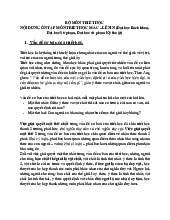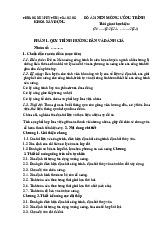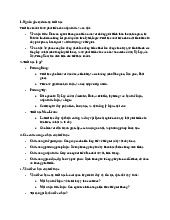



Preview text:
lOMoAR cPSD| 40367505
The vikings wayfaring way
In the last century, Vikings have been perceived in numerous different ways – vilified as
conquerors and romanticised as adventurers. How Vikings have been employed in nation-building is a topic of some interest.
In English, Vikings are also known as Norse or Norsemen. Their language greatly influenced
English, with the nouns, ‘Hell’, ‘husband’, ‘law’, and ‘window’, and the verbs, ‘blunder’, ‘snub’,
‘take’, and ‘want’, all coming from Old Norse. However, the origins of the word ‘Viking’, itself,
are obscure: it may mean ‘a Scandinavian pirate’, or it may refer to ‘an inlet’, or a place called
Vik, in modem-day Norway, from where the pirates came. These various names – Vikings, Norse,
or Norsemen, and doubts about the very word ‘Viking’ suggest historical confusion.
Loosely speaking, the Viking Age endured from the late eighth to the mid-eleventh centuries.
Vikings sailed to England in AD 793 to storm coastal monasteries, and subsequently, large swathes
of England fell under Viking rule – indeed several Viking kings sat on the English throne. It is
generally agreed that the Battle of Hastings, in 1066, when the Norman French invaded, marks the
end of the English Viking Age, but the Irish Viking age ended earlier, while Viking colonies in
Iceland and Greenland did not dissolve until around AD 1500.
How much territory Vikings controlled is also in dispute – Scandinavia and Western Europe
certainly, but their reach east and south is uncertain. They plundered and settled down the Volga
and Dnieper rivers, and traded with modem-day Istanbul, but the archaeological record has yet to
verify that Vikings raided as far away as Northwest Africa, as some writers claim.
The issue of control and extent is complex because many Vikings did not return to
Scandinavia after raiding but assimilated into local populations , often becoming
Christian. To some degree, the Viking Age is defined by religion. Initially, Vikings were
polytheists, believing in many gods, but by the end of the age, they had permanently accepted a
new monotheistic religious system – Christianity.
This transition from so-called pagan plunderers to civilised Christians is significant and is the view
promulgated throughout much of recent history. In the UK, in the 1970s for example,
schoolchildren were taught that until the Vikings accepted Christianity they were nasty heathens lOMoAR cPSD| 40367505
who rampaged throughout Britain. By contrast, today’s children can visit museums where Vikings
are celebrated as merchants, pastoralists, and artists with a unique worldview as well as conquerors.
What are some other interpretations of Vikings? In the nineteenth century, historians in Denmark,
Norway, and Sweden constructed their own Viking ages for nationalistic reasons. At that time, all
three countries were in crisis. Denmark had been beaten in war and ceded territory to what is now
Germany. Norway had become independent from Sweden in 1905 but was economically
vulnerable, so Norwegians sought to create a separate identity for themselves in the past as well
as the present. The Norwegian historian, Gustav Storm, was adamant it was his forebears and not
the Swedes’ or Danes’ who had colonised Iceland, Greenland, and Vinland, in what is now Canada.
Sweden, meanwhile, had relinquished Norway to the Norwegians and Finland to the Russians;
thus, in the late nineteenth century, Sweden was keen to boost its image with rich archaeological
finds to show the glory of its Viking past.
In addition to augmenting nationalism, nineteenth-century thinkers were influenced by an
Englishman, Herbert Spencer, who described peoples and cultures in evolutionary terms similar
to those of Charles Darwin. Spencer coined the phrase ‘survival of the fittest’, which includes the
notion that, over time, there is not only technological but also moral progress. Therefore, Viking
heathens’ adoption of Christianity was considered an advantageous move. These days, historians
do not compare cultures in the same way, especially since, in this case, the archaeological record
seems to show that heathen Vikings and Christian Europeans were equally brutal.
Views of Vikings change according to not only to forces a ecting historians at the time ff of their
research but also according to the materials they read. Since much knowledge of Vikings comes
from literature composed up to 300 years after the events they chronicle, some Danish historians
cal1 these sources ‘mere legends’.
Vikings did have a written language carved on large stones, but as few of these survive today, the
most reliable contemporary sources on Vikings come from writers from other cultures, like the
ninth-century Persian geographer, Ibn Khordadbeh. lOMoAR cPSD| 40367505
In the last four decades, there have been wildly varying interpretations of the Viking influence in
Russia. Most non-Russian scholars believe the Vikings created a kingdom in western Russia and
modern-day Ukraine led by a man called Rurik. After AD 862, Rurik’s descendants continued to
rule. There is considerable evidence of this colonisation: in Sweden, carved stones, still standing,
describe the conquerors’ journeys; both Russian and Ukrainian have loan words from Old Norse;
and, Scandinavian first names, like Igor and Olga, are still popular. However, during the Soviet
period, there was an emphasis on the Slavic origins of most Russians.
(Appearing in the historical record around the sixth century AD, the Slavs are thought to have
originated in Eastern Europe.) This Slavic identity was promoted to contrast with that of the
neighbouring Viking Swedes, who were enemies during the Cold War.
These days, many Russians consider themselves hybrids. Indeed recent genetic studies support a
Norse-colonisation theory: western Russian DNA is consistent with that of the inhabitants of a
region north of Stockholm in Sweden.
The tools available to modern historians are many and varied, and their findings may seem less
open to debate. There are linguistics, numismatics, dendrochronology, archaeozoology,
palaeobotany, ice crystallography, climate and DNA analysis to add to the translation of runes and
the raising of mighty warships. Despite these, historians remain children of their times. 1.obscure 2.793 3.Northwest Africa 4.local populations 5.religious 6.F 7.D 8.E 9.A lOMoAR cPSD| 40367505 10.G 11.B 12.C 13.H 14.D




